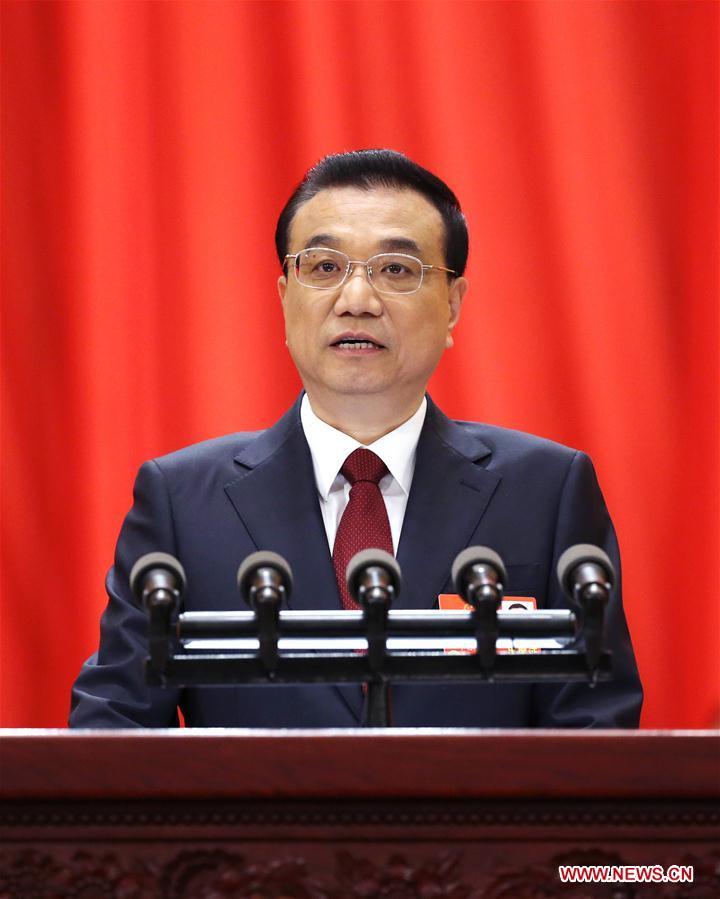



China aims to see economic expansion at around 6.5 percent this year, unchanged from 2017, according to the government work report released Monday.
"Given China's economic fundamentals and capacity for job creation, GDP growth of around 6.5 percent will enable China to achieve relatively full employment," Chinese Premier Li Keqiang said while addressing the opening of the first session of the 13th National People's Congress, China's national legislature.

An attainable goal
The same GDP growth target was set last year, but the world's second largest economy outperformed, expanding 6.9 percent in 2017, picking up speed for the first time in seven years.
The projected economic expansion this year should also be within reach without much difficulty, according to Chinese economic observers.
The International Monetary Fund in January raised its forecast for China's GDP growth from 6.5 percent to 6.6 percent amid an upbeat outlook for the global recovery. International investment banks including UBS, J.P. Morgan and Nomura also revised their China 2018 GDP growth prediction upward to as high as 6.7 percent.
China's future economic growth is not without headwinds. Recent rising trade friction with the United States is widely considered to be a major roadblock checking the country's external demand, but its impact might be overestimated.
Targeted tariffs and restrictions may hurt related sectors, but the macro impact on China's exports or GDP growth will be very small as a stronger global recovery helps to drive 2018 export growth beyond earlier forecasts, more than offsetting any negative impact from trade friction, according to Wang Tao, UBS chief China economist.
Despite possible slower infrastructure and property investment this year, consumption growth should stay resilient in 2018 thanks to solid income growth, underpinned by robust export and service sector activity, Wang added.
The record high spending by travelers and movie-goers during the week-long Chinese New Year holiday heralds a thriving year for consumption as increasingly affluent Chinese are more willing to pay for higher-quality products and unique experiences.
China's economic planner, the National Development and Reform Commission, expects retail sales of consumer goods to rise around 10 percent in 2018, as well as a rising prominence of the service sector, whose added value might share 52.2 percent of GDP.
A different growth
Although China's economic expansion target is unchanged, it might deliver different growth as China prioritizes growth quality over pace.
The projected growth rate reflects China's position of not over-emphasizing speed but stressing improvements in quality and the effect of development, according to another NDRC report.
"We will strongly promote high-quality development," Premier Li said.
The 19th Communist Party of China (CPC) National Congress as well as the central economic work conference both played down the necessity of pursuing high-speed GDP growth.
The world's second largest economy has sailed into a new era when the country gears up to build a moderately prosperous society in all respects, not just impressive economic figures.
A more sensible approach towards GDP targets is also being taken by local governments. Of the provincial governments, 15 lowered this year's growth target and 15 kept their figures unchanged, with only one expecting a higher growth.
With less emphasis on GDP as the sole performance evaluation indicator, local governments can shift more attention to other key indicators that gauge growth quality such as people's income, and the development of healthcare, education and the environment, according to Liu Shijin, a national political advisor and former senior state think tank official.
China has composite advantages, Premier Li said, citing a complete industrial system, a vast market, abundant human resources and dynamic entrepreneurs and innovators.
"All this means that we have the ability and the conditions to achieve higher quality, more efficient, fairer and more sustainable development," Li said.
Still global stabilizer
The "around 6.5 percent" GDP target, if achieved, will still be one of the fastest GDP growths worldwide. Although it has bid farewell to breakneck expansion, China, with a higher-quality growth, will continue its role of stabilizing the global economy by further opening up its market.
More dividends from China's growth will be shared globally with a string of opening-up policies to be rolled out to mark the 40th anniversary of the country's reform and opening-up drive, which made China what it is today.
"Bolder moves of opening-up means fresh opportunities for the rest of the world as the Chinese market is big and keeps generating new demand," said Wang Ruijun, an NPC deputy from south China's Guangdong Province, the frontier of the country's reform and opening-up drive.
The country will completely open up its general manufacturing sector to foreign investors this year. Meanwhile, access to sectors like telecommunications, medical services, education, elderly care and new energy vehicles will also be expanded for foreign investment, according to Li.
China's rising middle-income group, with a population of around 400 million, means a huge consumption market for foreign firms thanks to their increasingly bigger appetite for foreign products.
To encourage imports, China will host the first China International Import Expo this year and lower import tariffs on products including automobiles and a number of everyday consumer goods.
"We will open our market wider to promote industry upgrading and more balanced development of trade, and to provide Chinese consumers with a broader range of choices," Li added.
